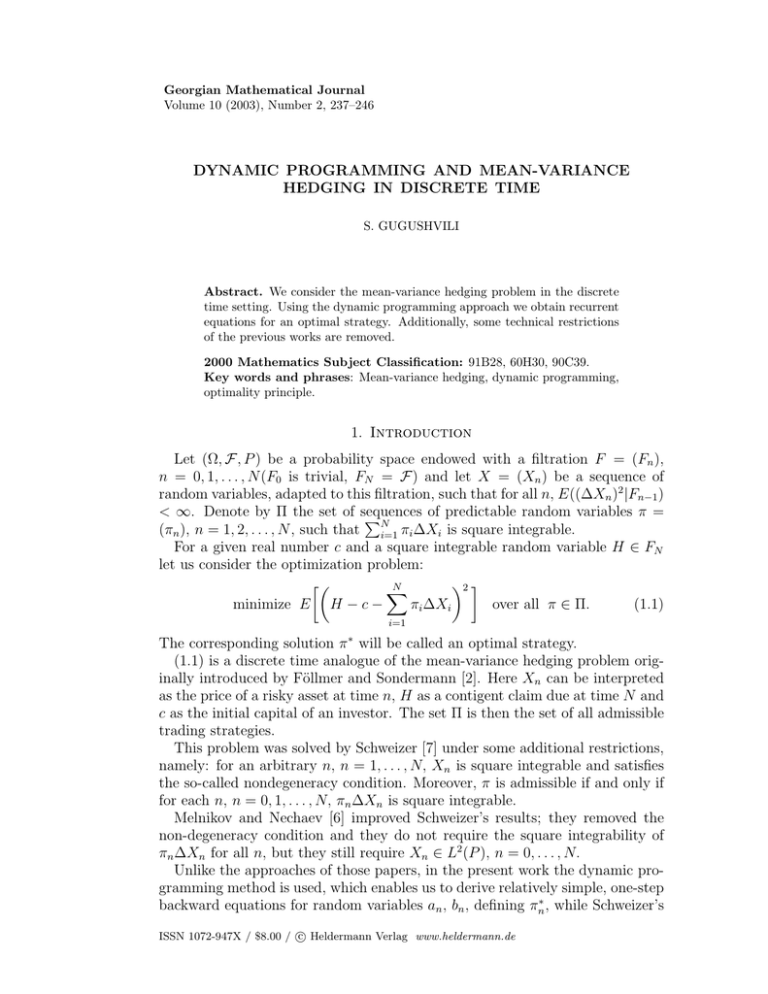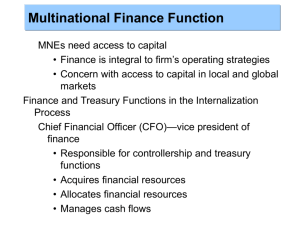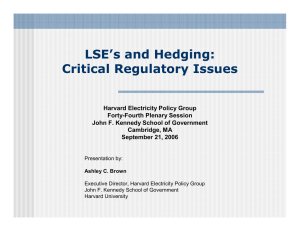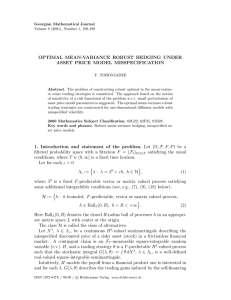DYNAMIC PROGRAMMING AND MEAN-VARIANCE HEDGING IN DISCRETE TIME
advertisement

Georgian Mathematical Journal Volume 10 (2003), Number 2, 237–246 DYNAMIC PROGRAMMING AND MEAN-VARIANCE HEDGING IN DISCRETE TIME S. GUGUSHVILI Abstract. We consider the mean-variance hedging problem in the discrete time setting. Using the dynamic programming approach we obtain recurrent equations for an optimal strategy. Additionally, some technical restrictions of the previous works are removed. 2000 Mathematics Subject Classification: 91B28, 60H30, 90C39. Key words and phrases: Mean-variance hedging, dynamic programming, optimality principle. 1. Introduction Let (Ω, F, P ) be a probability space endowed with a filtration F = (Fn ), n = 0, 1, . . . , N (F0 is trivial, FN = F) and let X = (Xn ) be a sequence of random variables, adapted to this filtration, such that for all n, E((∆Xn )2 |Fn−1 ) < ∞. Denote by Π the set of sequences of predictable random variables π = PN (πn ), n = 1, 2, . . . , N , such that i=1 πi ∆Xi is square integrable. For a given real number c and a square integrable random variable H ∈ FN let us consider the optimization problem: ·µ ¶2 ¸ N X minimize E H − c − πi ∆Xi over all π ∈ Π. (1.1) i=1 The corresponding solution π ∗ will be called an optimal strategy. (1.1) is a discrete time analogue of the mean-variance hedging problem originally introduced by Föllmer and Sondermann [2]. Here Xn can be interpreted as the price of a risky asset at time n, H as a contigent claim due at time N and c as the initial capital of an investor. The set Π is then the set of all admissible trading strategies. This problem was solved by Schweizer [7] under some additional restrictions, namely: for an arbitrary n, n = 1, . . . , N, Xn is square integrable and satisfies the so-called nondegeneracy condition. Moreover, π is admissible if and only if for each n, n = 0, 1, . . . , N, πn ∆Xn is square integrable. Melnikov and Nechaev [6] improved Schweizer’s results; they removed the non-degeneracy condition and they do not require the square integrability of πn ∆Xn for all n, but they still require Xn ∈ L2 (P ), n = 0, . . . , N. Unlike the approaches of those papers, in the present work the dynamic programming method is used, which enables us to derive relatively simple, one-step backward equations for random variables an , bn , defining πn∗ , while Schweizer’s c Heldermann Verlag www.heldermann.de ISSN 1072-947X / $8.00 / ° 238 S. GUGUSHVILI or Melnikov and Nechaev’s recurrent equations for quantities βn , ρn defining πn∗ involve all previous βi from n + 1 to N. Moreover, the requirement of the square integrability of Xn , n = 0, 1, . . . , is removed. The dynamic programming method has already been applied to the mean-variance hedging problem in [3], [5], but they do not cover our case as [3] deals with the diffusion model, while in [5] the asset process X, which is a semimartingale, and the filtration F are supposed to be continuous. The paper is organized as follows: in Section 2 we introduce the value function V (n, x) corresponding to (1.1). Proposition 2.1 gives us the main working tool, the Bellman equation. In Section 3 we formulate and prove the main theorem. Section 4 is dedicated to the discussion of the obtained results. Finally, Appendix contains some results, used throughout the paper. 2. Backward Equation for V (n, x) First let us introduce some conventions and notation: a) If A is an empty set, then let X Y Ya = 0, Ya = 1. a∈A a∈A b) The uncertainty 00 = 0. c) Relations between random variables are understood in the a.s. sense. d) Π(n, N ) denotes the set of π ∈ Π such, that πi = 0 for i ≤ n. Let us define the value function V (n, x) corresponding to (1.1) as µµ V (n, x) = essinf E π∈Π(n,N ) H −x− N X ¶2 ¯ ¶ ¯ πi ∆Xi ¯ Fn . i=n+1 Note that V (N, x) = (H − x)2 . Proposition 2.1. The function V (n, x) satisfies the recurrent equation ¡ ¢ V (n − 1, x) = essinf E V (n, x + πn ∆Xn )|Fn−1 (2.1) π∈Π(n−1,N ) with the boundary condition V (N, x) = (H − x)2 . b ∈ Π(n − 1, N ) we Proof. Due to Proposition A1 of Appendix for every fixed π have ¢ ¡ V (n − 1, x) ≤ E V (n, x + π bn ∆Xn )|Fn−1 . Therefore, taking essinf, we obtain V (n − 1, x) ≤ essinf π∈Π(n−1,N ) ¢ ¡ E V (n, x + πn ∆Xn )|Fn−1 . (2.2) DYNAMIC PROGRAMMING AND MEAN-VARIANCE HEDGING 239 Conversely (b π = (b πn ) is fixed), ¡ ¢ E V (n, x + π bn ∆Xn )|Fn−1 µ µµ ¶2 ¯ ¶ ¯ ¶ N X ¯ ¯ =E essinf E H −x−π bn ∆Xn − πi ∆Xi ¯ Fn ¯ Fn−1 π∈Π(n−1,N ) i=n+1 µ µµ ¶2 ¯ ¶ ¯ ¶ N X ¯ ¯ ≤E E H −x− π bi ∆Xi ¯ Fn ¯ Fn−1 i=n µµ =E H −x− N X ¶2 ¯ ¶ ¯ π bi ∆Xi ¯ Fn−1 . i=n Taking essinf of both sides, we get ¡ ¢ essinf E V (n, x + πn ∆Xn )|Fn−1 π∈Π(n−1,N ) µµ ≤ essinf π∈Π(n−1,N ) E H −x− N X ¶2 ¯ ¶ ¯ πi ∆Xi ¯ Fn−1 = V (n − 1, x) i=n which together with (2.2) proves (2.1). ¤ 3. Main Result After above preliminary result, we are ready to formulate the main theorem. Theorem 1. Assume that E((∆Xn )2 |Fn−1 ) < ∞ for all 1 ≤ n ≤ N. Then the value function V (n, x) is a square trinomial in x, V (n, x) = an x2 + 2bn x + cn , where the Fn -measurable random variables an , bn and cn satisfy the backward recurrent equations (E(an+1 ∆Xn+1 |Fn ))2 , E(an+1 (∆Xn+1 )2 |Fn ) E(an+1 ∆Xn+1 |Fn )E(bn+1 ∆Xn+1 |Fn ) bn = E(bn+1 |Fn ) − , E(an+1 (∆Xn+1 )2 |Fn ) (E(bn+1 ∆Xn+1 |Fn ))2 , cn = E(cn+1 |Fn ) − E(an+1 (∆Xn+1 )2 |Fn ) an = E(an+1 |Fn ) − (3.1) (3.2) (3.3) with the boundary conditions aN = 1, bN = −H, cN = H 2 . Moreover, an optimal strategy π ∗ = (πn∗ ) is given by ¶ µ n−1 X E(bn ∆Xn |Fn−1 ) E(an ∆Xn |Fn−1 ) ∗ ∗ πn = − − c+ πi ∆Xi . 2 2 |F E(an (∆Xn ) |Fn−1 ) E(a (∆X ) ) n n n−1 i=1 (3.4) 240 S. GUGUSHVILI Proof. For n = N we have V (N, x) = (H − x)2 ; hence V (N, x) is a square trinomial in x and aN = 1, bN = −H, cN = H 2 . Suppose that for some n, V (n, x) is a square trinomial in x V (n, x) = an x2 + 2bn x + cn , and 0 ≤ an ≤ 1. Since V (n, x) ≥ 0, this implies that b2n ≤ an cn , whence (ω : an = 0) ⊂ (ω : bn = 0). Moreover, by the Hölder inequality ¡ ¢2 ¡ √ √ ¢2 E(an ∆Xn |Fn−1 ) = E( an an ∆Xn |Fn−1 ) ¡ ¢ ≤ E an |Fn−1 )E(an (∆Xn )2 |Fn−1 , i.e., ¡ ¢ ¡ ¢ ω : E(an (∆Xn )2 |Fn−1 ) = 0 ⊂ ω : E(an ∆Xn |Fn−1 ) = 0 . ¡ ¢ If we denote by A the set ω : E(an (∆Xn )2 |Fn−1 ) = 0 , then £ ¤ £ ¤ E an (∆Xn )2 IA = E E(an (∆Xn )2 |Fn−1 )IA = 0, (3.5) (3.6) whence an (∆Xn )2 IA = 0. This implies that bn (∆Xn )2 IA = 0, and therefore bn ∆Xn IA = 0. Taking conditional expectation we get E(bn ∆Xn |Fn−1 )IA = 0, whence we finally obtain ¡ ¢ ¡ ¢ ω : E(an (∆Xn )2 |Fn−1 ) = 0 ⊂ ω : E(bn ∆Xn |Fn−1 ) = 0 . (3.7) Therefore essinf w.r.t. π ∈ Π(n − 1, N ) in ¡ ¢ E V (n, x + πn ∆Xn )|Fn−1 ¡ ¢ = E an (x + πn ∆Xn )2 + 2bn (x + πn ∆Xn ) + cn |Fn−1 ¡ ¢ ¡ ¢ = E an x2 + 2bn x + cn |Fn−1 + πn2 E an (∆Xn )2 |Fn−1 ¡ ¢ ¡ ¢ + 2πn xE(an ∆Xn |Fn−1 + E bn ∆Xn |Fn−1 ) ] (3.8) is attained for πn = − E(bn ∆Xn |Fn−1 ) E(an ∆Xn |Fn−1 ) −x . 2 E(an (∆Xn ) |Fn−1 ) E(an (∆Xn )2 |Fn−1 ) (3.9) Note that on the set A, πn can be chosen arbitrarily, e.g., it can be set to be 0. The agreement 00 = 0 allows one to write this in compact form (3.9). After substituting πn defined by the above formula in (3.8) and using (2.1), we obtain · ¸ (E(an ∆Xn |Fn−1 ))2 2 V (n − 1, x) = E(an |Fn−1 ) − x E(an (∆Xn )2 |Fn−1 ) · ¸ E(an ∆Xn |Fn−1 )E(bn ∆Xn |Fn−1 ) + 2 E(bn |Fn−1 ) − x E(an (∆Xn )2 |Fn−1 ) (E(bn ∆Xn |Fn−1 ))2 . + E(cn |Fn−1 ) − E(an (∆Xn )2 |Fn−1 ) DYNAMIC PROGRAMMING AND MEAN-VARIANCE HEDGING 241 Denoting (E(an ∆Xn |Fn−1 ))2 , E(an (∆Xn )2 |Fn−1 ) E(an ∆Xn |Fn−1 )E(bn ∆Xn |Fn−1 ) = E(bn |Fn−1 ) − , E(an (∆Xn )2 |Fn−1 ) (E(bn ∆Xn |Fn−1 ))2 = E(cn |Fn−1 ) − , E(an (∆Xn )2 |Fn−1 ) an−1 = E(an |Fn−1 ) − bn−1 cn−1 we obtain V (n − 1, x) = an−1 x2 + 2bn−1 x + cn−1 . Using the definition of an−1 and (3.5) it is easy to check that 0 ≤ an−1 ≤ 1. Therefore (3.6), (3.7) are satisfied for k = n − 1 as well and, consequently, using the induction, for all k = 0, . . . , N. Hence the reasoning used to find essinf is true for all k. Bellman’s principle suggests us that a natural candidate for an optimal solution is (3.4), where an , bn satisfy (3.1)–(3.2) with initial conditions aN = 1, P ∗ ∗ bN = −H. Let us show that XNπ = N integrable (i.e., π ∗ is i=1 πi ∆Xi is square P ∗ n admissible). For this it is sufficient to check that an (Xnπ )2 = an ( i=1 πi∗ ∆Xi )2 is integrable for all n. Since aN = 1, this will entail the square integrability of ∗ ∗ ∗ XNπ . Obviously, a0 (X0π )2 is integrable (as a0 ≤ 1 and X0π = c). If we prove the equality ¸ · (E(bn ∆Xn |Fn−1 ))2 π∗ 2 π∗ 2 , (3.10) E[an (Xn ) ] = E[an−1 (Xn−1 ) ] + E E(an (∆Xn )2 |Fn−1 ) then by induction it is sufficient to show that for all n, (E(bn ∆Xn |Fn−1 ))2 E(an (∆Xn )2 |Fn−1 ) is integrable. But this directly follows if we note that (cn , Fn ) is a submartingale since cn = V (n, 0) and for arbitrary x, (V (n, x), Fn ) is a submartingale, whence cn ≤ E(cN |Fn ) = E(H 2 |Fn ), √ and since for all n we have |bn | ≤ an cn , by the Hölder inequality √ (E( an cn ∆Xn |Fn−1 ))2 (E(bn ∆Xn |Fn−1 ))2 ≤ ≤ E(cn |Fn−1 ). E(an (∆Xn )2 |Fn−1 ) E(an (∆Xn )2 |Fn−1 ) Now let us verify (3.10). We have ¤ £ ∗ π∗ E an (Xnπ )2 ] = E[an (Xn−1 + πn∗ ∆Xn )2 ¤ £ π∗ π∗ 2 + an (πn∗ ∆Xn )2 = E an (Xn−1 ) + 2πn∗ an ∆Xn Xn−1 £ π∗ π∗ 2 = E E(an |Fn−1 )(Xn−1 ) + 2πn∗ E(an ∆Xn |Fn−1 )Xn−1 ¤ + (πn∗ )2 E(an (∆Xn )2 |Fn−1 ) · · E(bn ∆Xn |Fn−1 )E(an ∆Xn |Fn−1 ) π∗ 2 = E E(an |Fn−1 )(Xn−1 ) − 2 E(an (∆Xn )2 |Fn−1 ) 242 S. GUGUSHVILI ¸ (E(an ∆Xn |Fn−1 ))2 π∗ π∗ X X + n−1 n−1 E(an (∆Xn )2 |Fn−1 ) (E(bn ∆Xn |Fn−1 ))2 E(bn ∆Xn |Fn−1 )E(an ∆Xn |Fn−1 ) π∗ + +2 Xn−1 2 E(an (∆Xn ) |Fn−1 ) E(an (∆Xn )2 |Fn−1 ) ¸ (E(an ∆Xn |Fn−1 ))2 π∗ 2 + (X ) E(an (∆Xn )2 |Fn−1 ) n−1 ¸ · (E(an ∆Xn |Fn−1 ))2 π∗ 2 = E (E(an |Fn−1 ) − )(Xn−1 ) E(an (∆Xn )2 |Fn−1 ) ¸ · (E(bn ∆Xn |Fn−1 ))2 , +E E(an (∆Xn )2 |Fn−1 ) ∗ which is the desired result. Hence XNπ is square integrable. The optimality of π ∗ can be easily derived using the optimality criterion (Proposition A2), equations (3.1)–(3.2) and the fact that VP (n, x) is a square trinomial (one should substitute the expressions for V (n, c+ ni=1 πi∗ ∆Xi ) and ¯ V (n− Pn−1 ∗ Pn ∗ 1, c+ i=1 πi ∆Xi ) in the hypothetical equality E(V (n, c+ i=1 πi ∆Xi )¯Fn−1 ) = P ∗ V (n − 1, c + n−1 ¤ i=1 πi ∆Xi )). 4. Remarks and Applications Remark 4.1. Let us show how the obtained results are related to the solutions previously proposed in the literature. In order to make comparisons valid, suppose that Xn is square integrable for all n. Recall from [6] that an optimal solution is given by n−1 ³ ´ X ∗ ∗ πn = ρn − c + πi ∆Xi βn , (4.1) i=1 where the predictable processes β = (βk ) and ρ = (ρk ) are defined by the backward equations ¯ ¡ ¢ Q ¯ E ∆Xn N i=n+1 (1 − βi ∆Xi ) Fn−1 ¯ βn = ¡ (4.2) ¢, Q ¯ E (∆Xn )2 N i=n+1 (1 − βi ∆Xi ) Fn−1 ¯ ¡ ¢ Q ¯ E H∆Xn N i=n+1 (1 − βi ∆Xi ) Fn−1 ¯ (4.3) ρn = ¡ ¢. Q ¯Fn−1 E (∆Xn )2 N (1 − β ∆X ) i i i=n+1 The link between a = (ak ), b = (bk ) and β = (βk ), ρ = (ρk ) is quite simple, namely ¯ E(an ∆Xn ¯Fn−1 ) ¯ , βn = E(an (∆Xn )2 ¯Fn−1 ) ¯ E(bn ∆Xn ¯Fn−1 ) ¯ ρn = − . E(an (∆Xn )2 ¯Fn−1 ) Indeed, since aN = 1, bN = −H, these relations are true for n = N . The same fact for general n can be easily obtained using induction. Conversely, an and bn DYNAMIC PROGRAMMING AND MEAN-VARIANCE HEDGING 243 can be expressed in terms of βn+1 , . . . , βN as µ Y ¶ N ¯ ¯ an = E (1 − βi ∆Xi ) Fn , µ i=n+1 N Y bn = − H ¶ ¯ (1 − βi ∆Xi ) ¯ Fn , i=n+1 which again can be proved by induction. As it can be seen from (4.2)–(4.3), equations (3.1)–(3.2) provide some advantages for describing an optimal strategy as they are one-step, unlike (4.2)–(4.3), which involve βn+1 , . . . , βN . On the other hand, (4.1) seems simpler than (3.4). Remark 4.2. Note that the requirement of the square integrability of Xn , n = 0, . . . , N , of [6], [7] in our setting is substituted by a weaker one: ¯ ¡ ¢ E (∆Xn )2 ¯Fn−1 < ∞ for all n. Remark 4.3. It is interesting to determine the value of the shortfall ·µ ¶2 ¸ N X ∗ ∗ R =E H −c− πi ∆Xi i=1 ∗ associated with the optimal strategy π . Noting that ·µ ¶2 ¸ N X ∗ E H −c− πi ∆Xi = V (0, c), i=1 we obtain R∗ = a0 c2 + 2b0 c + c0 . Remark 4.4. When hedging a contigent claim, we usually are also interested in determining the price of this claim, i.e. we consider the problem N h³ ´2 i X minimize E H − x − πi ∆Xi over all (x, π) ∈ R × Π. i=1 For every fixed c and arbitrary π ∈ Π we have N N ´2 i h³ ´2 i h³ X X ∗ ≤E H −c− πi ∆Xi , E H −c− πi (c)∆Xi i=1 ∗ i=1 where π (c) is defined by (3.1)–(3.4). Let us minimize the left-hand side by c. Since it is equal to V (0, c) = a0 c2 + 2b0 c + c0 , the minimum is attained for −b0 /a0 (of course, if a0 6= 0) and a minimal shortfall is equal to b2 − a0 c0 . R∗ = − 0 a0 244 S. GUGUSHVILI If a0 = 0, then b0 = 0 too (see the proof of Theorem 1), which means that an optimal strategy π ∗ (c) does not depend on the initial capital c; therefore the price can be set to 0 and it can be again written as c∗ = − ab00 . The shortfall in this case equals c0 . Note that this result due to Remark 4.1 coincides with the solution proposed in [6]. ¤ Appendix P Lemma A1. ¯The family of random variables Λπn = E((H −x− ni=1 π bi ∆Xi − PN 2¯ π , n, N ), possesses the ε-lattice property (for ε = i=n+1 πi ∆Xi ) Fn ), π ∈ Π(b 0). Here Π(b π , n, N ) denotes the set of π ∈ Π such that πi = π bi for i = 0, 1, . . . , n. Proof. Let π 1 , π 2 ∈ Π(b π , n, N ) and let us define π 3 ∈ Π(b π , n, N ) as πi3 = πi1 IB + πi2 IB c , 1 2 where B = (ω : Λπn ≤ Λπn ). Then since B ∈ Fn , µµ ¶2 ¯ ¶ N X ¯ π3 3 Λn = E H −x− πi ∆Xi ¯ Fn i=1 µµ ¶2 ¯ ¶ N N X X ¯ 1 2 =E H − x − IB πi ∆Xi − IB c πi ∆Xi ¯ Fn i=1 i=1 µµ ¶2 ¯ ¶ N X ¯ 1 = IB E H −x− πi ∆Xi ¯ Fn i=1 µµ + IB c E H −x− N X πi2 ∆Xi ¶2 ¯ ¶ ¯ ¯ Fn i=1 µµ ¶2 ¯ ¶ µµ ¶2 ¯ ¶ N N X X ¯ ¯ 1 2 =E H −x− πi ∆Xi ¯ Fn ∧ E H −x− πi ∆Xi ¯ Fn i=1 and therefore the family i=1 Λπn has the ε-lattice property. ¤ P Proposition A1. The sequence V (n, x + ni=1 π bi ∆Xi ), Fn ) is a submartingale for arbitrary fixed π b ∈ Π, x ∈ R. Proof. We must prove that for any n ¶ ¶ µ ¶¯ µ µ n−1 n X X ¯ π bi ∆Xi . π bi ∆Xi ¯ Fn−1 ≥ V n − 1, x + E V n, x + i=1 i=1 Taking into account the previous lemma and Lemma 16.A.5 of [1], we obtain ¶ ¶2 ¶ ¯ µ µµ N n X X ¯ ¯ ¯ Fn ¯ Fn−1 πi ∆Xi π bi ∆Xi − E essinf E H −x− π∈Π(b π ,n,N ) i=1 i=n+1 DYNAMIC PROGRAMMING AND MEAN-VARIANCE HEDGING = = ≥ 245 µ µµ ¶¯ ¶¶ n N X X ¯ ¯ 2¯ essinf E E H −x− π bi ∆Xi − πi ∆Xi ) Fn ¯ Fn−1 π∈Π(b π ,n,N ) i=1 i=n+1 µµ ¶2 ¯ ¶ n N X X ¯ H −x− π bi ∆Xi − πi ∆Xi ¯ Fn−1 essinf E π∈Π(b π ,n,N ) essinf π∈Π(b π ,n−1,N ) i=1 i=n+1 µµ ¶2 ¯ ¶ n−1 N X X ¯ E H −x− π bi ∆Xi − πi ∆Xi ¯ Fn−1 i=1 µ = V n − 1, x + n−1 X i=n ¶ π bi ∆Xi , i=k which is the desired result. ¤ Proposition A2 (Optimality Principle). π ∗ ∈ Π is optimal if and only Pn ∗ if the sequence (V (n, c + i=1 πi ∆Xi ) , Fn ) is a martingale. Proof. Necessity. Suppose that π ∗ = (πn∗ ) is optimal. Then since (V (n, c + Pn ∗ i=1 π ∆Xi ), Fn ) is a submartingale, due to Lemma 6.6 of [4] it is sufficient to check the equality · µ ¶¸ N X ∗ E V N, c + πi ∆Xi = E[V (0, c)]. i=1 We have · µ ¶¸ ·µ ¶2 ¸ N N X X ∗ ∗ E V N, c + πi ∆Xi =E H −c− πi ∆Xi . i=1 i=1 ∗ Noting that the optimality of π means ·µ ¶2 ¸ N X ∗ V (0, c) = E H − c − πi ∆Xi , i=1 we finally obtain · µ ¶¸ N X ∗ E V N, c + πi ∆Xi = E[V (0, c)]. i=1 P Sufficiency. Suppose that (V (n, c + ni=1 πi∗ ∆Xi ), Fn ) is a martingale. Then ¶¯ ¶ µ µ N X ¯ ∗ E V N, c + πi ∆Xi ¯ F0 = V (0, c), i=1 whence ·µ E H −c− N X ¶2 ¸ πi∗ ∆Xi = V (0, c), i=1 which means that π ∗ is optimal. ¤ 246 S. GUGUSHVILI Acknowledgement The author would like to thank the referee for useful remarks and N. Lazrieva and M. Mania for many helpful comments. References 1. R. Elliott, Stochastic calculus and applications. Applications of Mathematics, 18. Springer-Verlag, New York, 1982. 2. H. Föllmer and D. Sondermann, Hedging of non-redundant contigent claims. Contributions to mathematical economics, 205–223, North-Holland, Amsterdam, 1986. 3. J. P. Laurent and H. Pham, Dynamic programming and mean-variance hedging. Finance Stoch. 3(1999), No. 1, 83–110. 4. R. Sh. Liptser and A. N. Shiryaev, Statistics of random processes. (Russian) Nauka, Moscow, 1974. 5. M. Mania and R. Tevzadze, Backward stochastic PDE and hedging in incomplete markets. Proc. A. Razmadze Math. Inst. 130(2002), 39–72. 6. A. V. Mel’nikov and M. L. Nechaev, On the mean-variance hedging of contingent claims. (Russian) Teor. Veroyatnost. i Primenen. 43(1998), No. 4, 672–691; English transl.: Theory Probab. Appl. 43(1999), No. 4, 588–603. 7. M. Schweizer, Variance-optimal hedging in discrete time. Math. Oper. Res. 20(1995), No. 1, 1–32. (Received 3.10.2002) Author’s address: Department of Applied Mathematics Georgian Technical University 77, Kostava St., Tbilisi 0175 Georgia E-mail: shota@gtu.edu.ge






